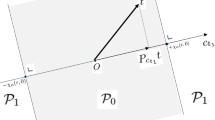Abstract
Averages are measured for diagnosis, prediction, or surveillance. However, averages reveal nothing about fluctuations, and extreme values may be more significant than the average. The analyst can choose decision variables: path length and other parameters. This paper explores the choice of decision variables to achieve robustness against pernicious uncertainty when interpreting an average, in face of uncertain fluctuations of the averaged variable. We also explore the choice of decision variables to achieve opportuneness from propitious uncertainty. Trade-offs and “trade-ons” between robust and opportune decision variables are identified. Three examples are developed: enforcing speed limits; inferring levels of economic activity; and statistical hypothesis testing. We use concepts of robustness and opportuneness from info-gap decision theory. We also explore the relation between the probability of success and the non-probabilistic robustness to uncertainty, demonstrating conditions where robustness is a proxy for probability.







Similar content being viewed by others
Notes
OECD=100 in year 2000 at 2000 price levels and PPPs.
References
Ben-Haim Y. Set-models of information-gap uncertainty: axioms and an inference scheme. J Franklin Inst. 1999;336:1093–117.
Ben-Haim Y. Info-gap decision theory: decisions under severe uncertainty. 2nd ed. London: Academic Press; 2006.
Ben-Haim Yakov. Info-gap forecasting and the advantage of sub-optimal models. Eur J Oper Res. 2009;197:203–13.
Ben-Haim Yakov. Info-gap economics: an operational introduction. Hampshire: Palgrave-Macmillan; 2010.
Ben-Haim Y. Robust satisficing and the probability of survival. Int J Syst Sci. 2014;45(1):3–19 (appearing on-line 9 May 2012.).
Ben-Haim Y. Inferring extreme values from measured averages under deep uncertainty. ASME J Verif Valid Uncertain Quantif. 2022;7: 021002.
Davidovitch L. Strategic Interactions Under Severe Uncertainty. PhD thesis, Technion-Israel Institute of Technology. 2009.
CDC. https://www.cdc.gov/alcohol/faqs.htm, Accessed 28 Apr 2021.
Delle Monache ML, Piccoli B, Rossi F. Traffic regulation via controlled speed limit. SIAM/ASA J Optim Control. 2017;55(5):2936–58.
Dempster AP. Upper and lower probabilities induced by multivalue mappings. Ann Math Stat. 1967;38:325–39.
Ewing ME, Liechty BC, Black DL. A general methodology for uncertainty quantification in engineering analyses using a credible probability box. J Verif Valid Uncertain Quantif. 2018;3(021003):1–12.
Ferson S. RAMAS risk Calc 4.0 software: risk assessment with uncertain numbers. Boca Raton: Lewis Publishers; 2002.
Hacking I. The emergence of probability: a philosophical study of early ideas about probability. Induction and statistical inference. Cambridge: Cambridge University Press; 1975.
Klir GJ. Uncertainty and information: foundations of generalized information theory. Wiley; 2006.
Kolmogorov AN. Foundations of the theory of probability, 2nd English edition trans. by N. Morrison, based on the 1933 German monograph 1933.
Lejewski C. Jan Lukasiewicz. In: Edwards P (ed) The encyclopedia of philosophy. Simon and Schuster Macmillan, 1996. p. 5.
Long G. Acceleration characteristics of starting vehicles, Transportation Research Board, 79th Annual Meeting, January 9–13. Washington. Paper No: DC; 2000. p. 00-0980.
Miranda E. A survey of the theory of coherent lower previsions. Int J Approx Reason. 2008;48:628–58.
Mood AM, Graybill Franklin A, Boes DC. Introduction to the theory of statistics. 3rd ed. McGraw-Hill; 1974.
OECD Factbook: economic, environmental and social statistics 2010.
Ozkul MH, Ozkul T. A fuzzy-logic-based model for assessment of human facial harmony based on theory of averages. J Franklin Inst. 2011;348:2216–34.
Porter TM. The Rise of Statistical Thinking: 1820–1900. Princeton: Princeton University Press; 1986.
Shafer G. A mathematical theory of evidence. Princeton University Press; 1976.
Stigler SM. The history of statistics: the measurement of uncertainty before 1900. Harvard University Press; 1986.
Wald A. Statistical decision functions which minimize the maximum risk. Ann Math. 1945;46(2):265–80.
Walley P. Measures of uncertainty in expert systems. Artif Intell. 1996;83:1–58.
Zadeh LA. Fuzzy sets. Inf Control. 1965;8:338–53.
Author information
Authors and Affiliations
Corresponding author
Ethics declarations
Conflict of interest
The authors declare that they have no conflict of interest.
Additional information
Publisher's Note
Springer Nature remains neutral with regard to jurisdictional claims in published maps and institutional affiliations.
This article is part of the topical collection “Advances on Operations Research and Enterprise Systems” guest edited by Marc Demange, Federico Liberatore and Greg H. Parlier.
A Maximum Acceleration
A Maximum Acceleration
Consider any infinitesimal segment of length \(\mathrm{d}x\) along the road. The speeds at the start and end of this segment are related as:
The derivative in this relation can be written:
where \(\dot{v}(t)\) is the temporal acceleration of the car. Combining the last two relations yields:
Hence, assuming that v(x) is positive, the increment in velocity on any infinitesimal segment of road is maximal if the car accelerates maximally. The cumulative effect is that the final speed is maximal if the car accelerates maximally throughout the travel, even though this actually minimizes the time during which acceleration occurs.
Rights and permissions
Springer Nature or its licensor (e.g. a society or other partner) holds exclusive rights to this article under a publishing agreement with the author(s) or other rightsholder(s); author self-archiving of the accepted manuscript version of this article is solely governed by the terms of such publishing agreement and applicable law.
About this article
Cite this article
Ben-Haim, Y. Measured Averages and Inferred Extremes: Info-Gap Analysis of Deep Uncertainty. SN COMPUT. SCI. 4, 60 (2023). https://doi.org/10.1007/s42979-022-01463-9
Received:
Accepted:
Published:
DOI: https://doi.org/10.1007/s42979-022-01463-9




